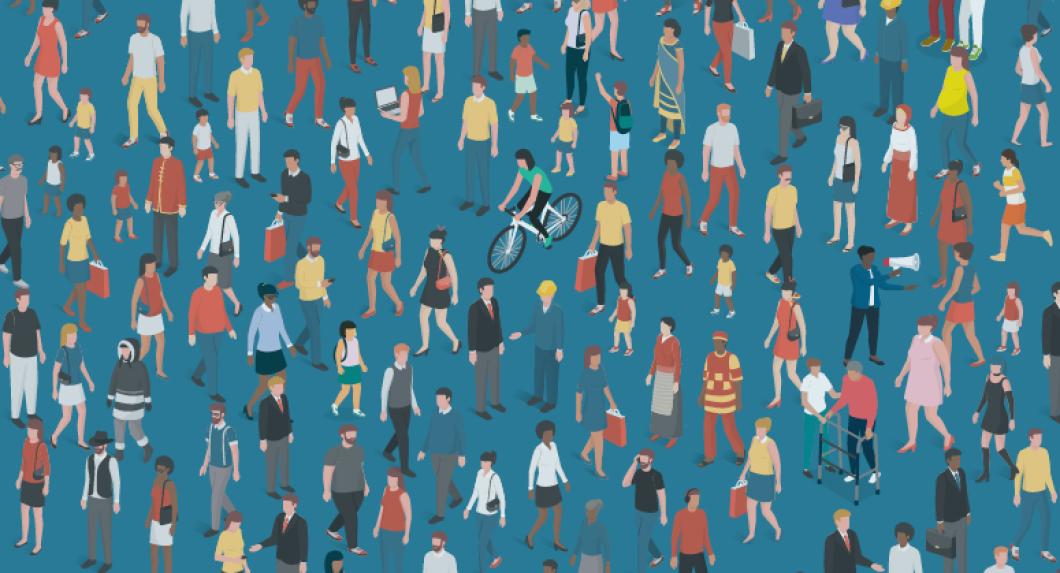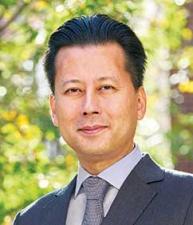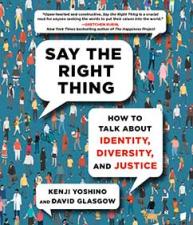In uncomfortable exchanges on matters of diversity and inclusion, many people fear misspeaking. As a result, they often leave crucial issues unresolved. Kenji Yoshino and David Glasgow LLM ’14 decided to respond to that uncertainty by writing Say the Right Thing: How to Talk About Identity, Diversity, and Justice (Atria Books, 2023).
Yoshino, Chief Justice Earl Warren Professor of Constitutional Law and faculty director of NYU Law’s Meltzer Center for Diversity, Inclusion, and Belonging, and Glasgow, the Meltzer Center’s executive director, discovered in their extensive work on diversity and inclusion that many well-intentioned potential allies were stymied.
“We saw that people were dead-ending in two directions at opposite extremes,” Yoshino says. Some, he explains, were so afraid of saying the wrong thing and unintentionally hurting someone or getting canceled that they did nothing. Others charged forward while lacking the necessary knowledge, without succeeding in their efforts. “They’re kind of like a bull in a china shop, and they intervene in ways that are ultimately unhelpful, even to the people that they’re trying to help.”
To help readers avoid both pitfalls, Say the Right Thing articulates seven general principles illustrated by clear, engaging examples taken from major headlines and the co-authors’ own experiences. (Yoshino’s favorite anecdote describes comedian Tina Fey’s extended journey toward increased sensitivity about diversity and inclusion after some public missteps.) Published by Simon & Schuster in February, the book has been praised by figures as varied as MSNBC host Chris Hayes (“clear-eyed, rigorous, humane, but most importantly wise”), Morgan Stanley CEO James Gorman (“brimming with practical advice”), and actress Vanessa Williams (“an utterly transformative guide to building an inclusive culture”).
Principle 1 warns against four conversational traps—avoid, deflect, deny, and attack—that are common knee-jerk reactions when insensitivity is called out and that can shut down productive dialogue. Principle 2 encourages building resilience to face the intense discomfort inevitable in sensitive exchanges about diversity and inclusion, allowing allies to adopt a growth mindset in pursuit of better allyship. Principle 3 advocates cultivating curiosity by learning about experiences and viewpoints that are different from one’s own. Principle 4 explores how to disagree respectfully, while Principle 5 lays out how to apologize authentically. Principle 6 introduces the Platinum Rule, which “enhances the Golden Rule,” the authors write, “by urging you to help others as they would wish to be helped.”
The seventh and final principle may be the most counterintuitive: within reason, be an ally to a person who is a source of non-inclusive behavior. Yoshino and Glasgow write that “when people think about allyship, they usually see themselves sitting permanently in the ally position. But allyship is more like a game of musical chairs. Some days you’re the ally, some days you’re the affected person, and some days you’re the source…. If you look at the world assuming you’ll never be the source of non-inclusive behavior, it’s much easier to cancel people. If you look at the world assuming you’ll sometimes be the source, you’ll have a fundamentally different take on how sources should be treated…. If you refuse to educate and rehabilitate the source, you’re either placing that burden on affected people or leaving the source to stew alone without the assistance they may need to grow.”
Say the Right Thing responds to a cultural shift, coming after a wave of books and other works that in recent years have drawn urgent attention to previously unacknowledged prejudice in society—including racism, sexism, anti-LGBTQ bias, and more—and have challenged Americans to confront it. Now, says Yoshino, “people have shifted from ‘We’re going to sound the bell about this crisis’ to ‘We now need to do the more daily practical work of living up to our ideals.’”
“There are a lot of books out there that raise consciousness around issues of injustice itself to get people activated as allies,” Glasgow observes, “but not a lot out there that are actually giving people practical tools for how to navigate these conversations in their everyday lives.”
Yoshino, who along with Glasgow has spent the years since the Meltzer Center’s launch educating both NYU Law students and external organizations on diversity and inclusion (D&I) matters, calls the center an ideal laboratory for testing the book’s seven principles. The center has worked with organizations as eclectic as Black Theatre United, Earthjustice, DLA Piper, Microsoft, and Morgan Stanley to offer guidance on navigating diversity and inclusion issues.
“It’s brought us from the ivory tower into the trenches of trying to understand what works and what doesn’t in D&I,” says Yoshino. He adds, “Because we’re an academic center and we’re constantly asked to go into other organizations and help them…we get to have so many touchpoints with diversity and inclusion projects in different cultures, different organizations, different industries…. We think that we have touched many, many more organizations than the average D&I person has been able to because of where we sit in this ecosystem.”
The result is a book that, despite its broad focus on a range of issues and its abundance of real-life examples, clocks in at under 200 pages. “We want it to be a tool,” Yoshino adds, “and part of its being useful as a tool is that it can’t be a doorstop.” Glasgow adds: “We’ve written the book in the most accessible way that we can, and tried to strip it of a lot of jargon and academic language and use a lot of relevant pop-culture examples in order to really try to tap into the broadest possible audience for it.”
Perhaps most important, Yoshino and Glasgow make sure to remind readers why they want to be allies in the first place.
“In other areas of life, such as parenting, exercise, or studying a new language, people know the activity will involve discomfort and they do it anyway, because it generates its own rewards—meaningful relationships, greater health, or a sense of accomplishment,” they write. “The discomfort of identity conversations is no different. There’s joy in the struggle here too: new capabilities, a greater sense of purpose, and deeper human connections.”
Video: What is the book about, and what are you hoping readers will take away from it?
See more videos with the co-authors
Posted February 7, 2023
Updated August 10, 2023
Book cover design by Min Choi



